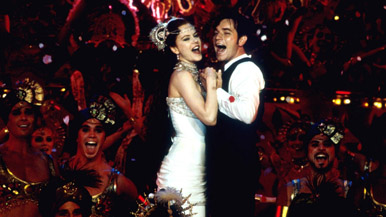A-List: Five Best Musicals of All Time
By J. Don Birnam
September 3, 2014
The movie, which was made as a musical for the screen first, unlike most other movie musicals these days, is based loosely on an Ancient Roman legend called “The Rape of the Sabine Women.” Yeah, I bet that title is welcoming. The story revolves around Adam, the oldest of seven husky, redheaded, somewhat backwards brothers living in the woods in Oregon in the 1850s, after he finds a bride to marry in town, Millie. Millie moves in and, to her surprise and dismay, finds that Adam has six other brothers who are even rougher and cruder than he is. She straightens them up somewhat, but, the times being what they are, they need wives. Eventually they “kidnap” six other townswomen, who actually wanted to be kidnapped because they liked the brothers but already had suitors. Times being what they are (there’s that phrase again), they couldn’t just leave with the brothers. Hilarity ensues and you can imagine the rest.
What’s so great about this movie is how deftly its makers use of the musical numbers to advance specific points in the plot. Rather than having musical sideshows a la “Razzle Dazzle” in Chicago, for instance, the numbers here weave seamlessly into the story. This is harder than it sounds, because it requires the dancers to use every day items as stage props. One of the best scenes is an early fight between the brothers and the women’s original suitors. It is clear from watching the dancing and singing alone in Seven Brides that the talent level required to be in one of these older musicals was much greater at that time than it is today. The dance numbers also feature another staple of older musicals that is now sadly mostly gone: the ensemble number. These are the hardest to pull off editing and choreography wise, and Seven Brides does so flawlessly.
In the end, the greatness of this movie was not lost on its time, resulting in an award-winning Broadway adaptation years later and netting the Oscar for Best Musical Score for a Musical. It did lose the Best Picture Oscar to Elia Kazan’s timeless classic, On the Waterfront. Perhaps the best known actor to have come out of this film is Russ Tamblyn, who features prominently in a movie that will predictably appear later on this list.
Worry not, this is perhaps the most obscure movie of the five I picked for this list, but it is worth a try if you’re looking for something older and unexpected to watch. Oh, and did I mention the movie is essentially a Western? That counts for something, right?
4. The Sound of Music
This 1965 all-time classic, winner of the Best Picture Oscar and the Best Director Oscar for Robert Wise, had to appear somewhere on the list. The movie is so steeped into our popular consciousness that it has gone full circle from great to trite and overhyped and back to great again.
The story needs little explanation, and stars Oscar winners (for other movies) Julie Andrews and Christopher Plummer as the independent-spirited nun Maria and the indomitable Colonel von Trapp, facing love and danger on the heels of the Nazi takeover of power. What’s remarkable about this movie is that it constituted the second Best Director Oscar for Robert Wise for a movie musical that decade (for the same movie Russ Tamblyn will show up in soon - there’s another clue) and that, at the time, it briefly displaced Gone With the Wind as the highest grossing movie of all-time. That’s pretty impressive if you ask me.
Continued:
1
2
3
4
|
|
|
|




